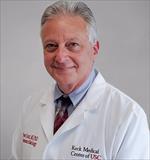Dr. Conti is a tenured Professor at the University of Southern California with academic appointments in the Departments of Radiology, Biomedical Engineering, and Pharmaceutical Sciences. He received his undergraduate degree from Johns Hopkins University and medical degree from Cornell University. His Ph.D. in Biophysics was completed at Memorial Sloan-Kettering Cancer Center. He is board certified in Nuclear Medicine (ABNM) and Diagnostic Radiology (ABR). Dr. Conti has been the Director of the USC PET Imaging Science Center since its inception in 1991. His research activities have focused on the development of novel PET and hybrid imaging agents for diagnostic and theranostic applications in cancer and other diseases. Dr. Conti has published over 300 peer-reviewed papers in the field of molecular imaging. He is the 2016 recipient of the Paul C Aebersold Award from the Society of Nuclear Medicine and Molecular Imaging for his achievements in the basic science of nuclear medicine, and was the 2018 Peter Valk Award recipient for his pioneering work in clinical Positron Emission Tomography. In 2019 he received a Lifetime Achievement Award from the American College of Nuclear Medicine and in January of 2020, the President’s Award for his service to the College. In June 2020, Dr. Conti received the Benedict Cassen Prize from the Education and Research Foundation for his pioneering work in the development of novel radiopharmaceuticals and clinical PET applications for cancer imaging, and his volunteerism and service to the molecular imaging community. The Prize honors the memory of Benedict Cassen, the inventor of the rectilinear radioisotope scanner—the first instrument capable of making an image of radiotracer distribution in body organs of living patients, and was seminal to the development of clinical nuclear medicine.


